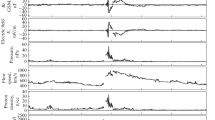Abstract
Geomagnetic super-storms of October and November 2003 are compared in order to identify solar and interplanetary variables that influence the magnitude of geomagnetic storms. Although these superstorms (DST < -300 nT) are associated with high speed CMEs, their DST indices show large variation. The most intense storm of November 20, 2003 (DSt∼ - 472 nT) had its source in a comparatively small active region and was associated with a relatively weaker, M-class flare, while the others had their origins in large active regions and were associated with strong X-class flares. An attempt has been made to implement a logistic regression model for the prediction of the occurrence of intense/superintense geomagnetic storms. The model parameters (regression coefficients) were estimated from a training data-set extracted from a data-set of 64 geo-effective CMEs observed during 1996–2002. The results indicate that logistic regression models can be effectively used for predicting the occurrence of major geomagnetic storms from a set of solar and interplanetary factors. The model validation shows that 100% of the intense storms (-200 nT < DSt < -100 nT) and only 50% of the super-intense (DST < -200 nT) storms could be correctly predicted.
Similar content being viewed by others
References
Burton, R. K., McPherron, R. L., Russell, C. T. 1975,J. Geophys. Res.,80, 4204–4214.
Gopalswamy, N., Yashiro, S., Liu, Y., Michalek, G., Vourlidas, A., Kaiser, M. L., Howard, R. A. 2005a,J. Geophys. Res,110(A9), doi10.1029/2004JA010958.
Gopalswamy, N., Yashiro, S., Michalek, G., Xie, H., Lepping, R. P., Howard, R. A. 2005b,Geophys. Res. Lett.,32(12), doi10.1029/2004GL021639.
McPherron, R., Siscoe, G., Arge, N. 2004,IEEE transactions on Plasma Science,32, 1425–1438.
Schwenn, R., Dal Lago, A., Huttunen, E., Gonzalez, W.D. 2005,Ann. Geophys.,23, 1033–1059.
Srivastava, N., Venkatakrishnan, P. 2002,Geophys. Res. Lett.,29, 1287–1290.
Srivastava, N., Venkatakrishnan, P. 2004,J. Geophys. Res.,109, A010103, doi10.1029/2003JA010175.
Srivastava, N. 2005a,Ann. Geophys.,23 (9) 2989–2995.
Srivastava, N. 2005b,Ann. Geophys.,23 (9) 2969–2974.
Author information
Authors and Affiliations
Rights and permissions
About this article
Cite this article
Srivastava, N. The challenge of predicting the occurrence of intense storms. J Astrophys Astron 27, 237–242 (2006). https://doi.org/10.1007/BF02702526
Issue Date:
DOI: https://doi.org/10.1007/BF02702526




